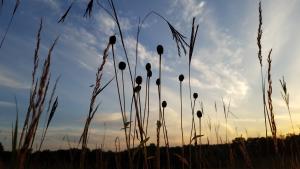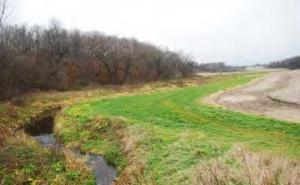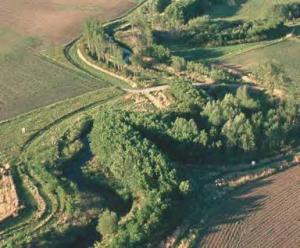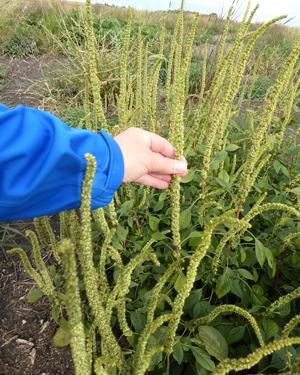What To Plant
Buffer Plantings Not Funded by Programs
When not using federal, state and/or local program funding, landowners have a variety of options for buffer vegetation.
Prairie Vegetation - Prairie plants have deep roots that provide water infiltration and filtering, and provide wildlife habitat benefits. They can also be used as a source of biomass. Native seed vendors can provide local buffer seed mixes to match site conditions. State seed mixes have also been developed by state agencies for a variety of conservation purposes (saturated buffers, biomass/biofuels, pollinator plantings, etc.). Buffers may be an opportunity to plant species beneficial to pollinators (milkweeds, Black-eyed Susan, wild mints, asters, goldenrods, etc.) in addition to native grasses. Pesticide drift is a concern for pollinators, so forbs are not recommended in buffer strips that are less than thirty feet wide and adjacent to cropland where pesticides are applied. Refer to NRCS Agronomy Technical Note #9 (pdf) for mitigation practices related to protecting pollinators from pesticide applications.
Hay and Forage Crops - A variety of perennial vegetation that is commonly used for hay and forage crops, such as alfalfa, clovers and forage grasses can be used for buffer plantings. NRCS practice standard CPS-512 Forage and Biomass Planting found in Agronomy Technical Note #31 provides seeding recommendations. Perennial Grains – Grains that are perennial can be planted and harvested from buffer areas. Kernza is an example of a species with increasing seed availability. More information is available about Kernza and other perennial species on the website for the Forever Green Initiative at the University of Minnesota.
Woody Vegetation – In addition to their ability to stabilize soils, woody vegetation can provide many other landscape benefits. Species such as Choke Cherry, Ninebark, Prairie Plum, Highbush Cranberry, Indigo Bush and Dogwood provide habitat for pollinators, songbirds and other wildlife. Some species such as Elderberry, Chokeberry, Hazelnuts and Willows are also being grown as commercial crops. Woody plants should be planted in combination with prairie vegetation or other perennial groundcover species to ensure effective stormwater filtering and to suppress weeds.
What Not To Plant
Invasive Species and State Noxious Weeds – Minnesota's Buffer Law states that invasive species and state noxious weeds cannot be planted on required buffers. The invasive risk of plants is often based on landscape conditions. For example, reed canary grass is a species that is discouraged as it displaces native vegetation in wetland and riparian landscapes. DNR’s invasive species website includes species that can be harmful to native plant communities.
Avoiding Palmer Amaranth and Other Weeds – The Minnesota Department of Agriculture is increasing inspections of seeds of native and non-native species to help prevent the introduction of Palmer Amaranth. For plantings with native seed, work with native seed vendors to obtain local sources. Inspect plantings for weeds and work with local conservation staff, Extension agents, or consultants if any problems are identified.
What To Plant If You Are In A Conservation Program
Buffer Plantings Funded by Conservation Programs
Federal, state and local conservation programs can be used for planting buffers. Each program has guidance for the types of vegetation to be used and for seed sources. Local SWCD staff can provide information about programs and funding options.
Federal Funding - Plantings conducted through the Conservation Reserve Enhancement Program (CREP) involve a perpetual Reinvest in Minnesota conservation easement and require the use of native vegetation, while Conservation Reserve Program (CRP) and Environmental Quality Incentive Program (EQIP) plantings can include native or non-native species depending on project goals. For federal programs, NRCS Field Office Technical Guide (FOTG) practice standards are used, along with Agronomy Technical Note #31 to define applicable practice standards and seed source requirements.
State Funding – NRCS conservation practice standards including CPS-393 “Filter Strip”, CPS-342 “Critical Area Planting”, and CPS-327 “Conservation Cover” are also used for state (BWSR) funded projects. Native species are strongly encouraged for projects to meet the Buffer Law, but if individual program requirements allow, local conservation district staff have the flexibility to approve non-native, non-invasive forage species for Buffer Law buffers (up to an average 50-foot width) and alternative practices when they will be planted for honey bee habitat, or when they will be hayed, grazed, and/or exposed to pesticide drift. See BWSR's Native Vegetation Guidelines for detailed information about seed and plant requirements for projects. The BWSR Buffer Establishment and Management Toolbox provides additional detailed information for project planning and implementation.
Local Funding – In addition to guiding buffer projects, local Soil and Water Conservation Districts may know of additional local funding sources, such as watershed districts and local conservation organizations. Individual funding sources may have specific guidance for planting options.
Additional Information
For information about how to assess when a buffer is meeting vegetation requirements of Minnesota’s Buffer Law, see the BWSR Buffer Law Implementation Guidance titled Vegetation Establishment Goals.




